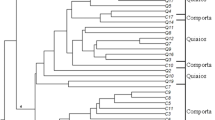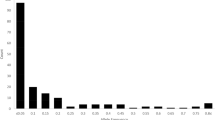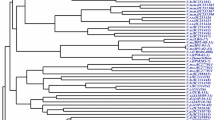Abstract
To better understand the genetic diversity and relationships of the two cultivated types of Perilla crop and their weedy types in Korea and Japan, we evaluated the genetic variations of 56 accessions by assessing five morphological characteristics and 18 SSR markers. The two cultivated types of var. frutescens and var. crispa were clearly distinguished by seed size, whereas most accessions of cultivated and weedy types of var. crispa cannot be distinguished strictly by seed characteristics. A total of 165 alleles with the SSR analysis were detected with an average number of 9.2 alleles per locus among the 56 Perilla accessions. The number of alleles per locus ranged from two for KWPE-56 and KWPE-39 to 21 for GBPFM-204. Additionally, the genetic diversity of each locus ranged from 0.497 at KWPE-56 and KWPE-39 to 0.959 at GBPFM-204, with an average of 0.692. The average genetic diversity values were 0.549, 0.685, 0.451 and 0.557 for cultivated and weedy types of var. frutescens and for cultivated and weedy types of var. crispa, respectively. The weedy type accessions of var. frutescens and var. crispa evidenced greater variation than the corresponding cultivated type accessions. The accessions of the cultivated and weedy types of var. frutescens and var. crispa from Korea exhibited greater SSR diversity than those of Japan. An UPGMA phylogenetic tree revealed three major groups, which was congruent with their morphological characteristics except for a few odd accessions. SSR markers clarified the genetic relationships between var. frutescens and var. crispa and helped improve our understanding of the genetic diversity of the two cultivated types of P. frutescens and their weedy types in Korea and Japan.




Similar content being viewed by others
References
Anderson JA, Churchill GA, Autrique JE, Tanksley SD, Sorrells ME (1993) Optimizing parental selection for genetic linkage maps. Genome 36:181–186
Dice LR (1945) Measures of the amount of ecologic association between species. Ecology 26:297–302
Hamza S, Hamida WB, Rebaϊ A, Harrabi M (2004) SSR-based genetic diversity assessment among Tunisian winter barley and relationship with morphological traits. Euphytica 135:107–118
Hancock JF (1992) Plant evolution and the origin of crop species. Prentice Hall, Englewood Cliffs
Kwon SJ, Lee JK, Kim NS, Yu JW, Dixit A, Cho EG, Park YJ (2005) Isolation and characterization of SSR markers in Perilla frutescens Britt. Mol Eco Notes 5:454–456
Lee JK, Kim NS (2007) Genetic diversity and relationships of cultivated and weedy types of Perilla frutescens collected from East Asia revealed by microsatellite markers. Korean J Breed Sci 39:491–499
Lee JK, Ohnishi O (2001) Geographic differentiation of morphological characters among Perilla crops and their weedy types in East Asia. Breed Sci 51:247–255
Lee JK, Ohnishi O (2003) Genetic relationships among cultivated types of Perilla frutescens and their weedy types in East Asia revealed by AFLP markers. Genet Resour Crop Evol 50:65–74
Lee JK, Nitta M, Kim NS, Park CH, Yoon KM, Shin YB, Ohnishi O (2002) Genetic diversity of Perilla and related weedy types in Korea determined by AFLP analyses. Crop Sci 42:2161–2166
Lee JK, Park BJ, Kim NS (2003) Genetic diversity and relationships among cultivated types of Perilla frutescens and their weedy types in Korea and Japan. Korean J Genet 25:215–222
Lee JK, Kwon SJ, Park BJ, Kim MJ, Park YJ, Ma KH, Lee SY, Kim JH (2007) Analysis of genetic diversity and Relationships of cultivated and weedy types of Perilla frutescens collected from Korea by using microsatellite markers. Korean J Genet 29:81–89
Li HL (1969) The vegetables of ancient China. Econ Bot 23:235–260
Makino T (1961) Makino’s new illustrated flora of Japan. Hokuryu-kan, Tokyo (in Japanese)
Nei M (1973) Analysis of gene diversity in subdivided populations. Proc Natl Acad Sci USA 70:3321–3323
Ni J, Colowit PM, Mackill DJ (2002) Evaluation of genetic diversity in rice subspecies using SSR markers. Crop Sci 42:601–607
Nitta M (2001) Origin of Perilla crops and their weedy type. Ph.D. Thesis, Kyoto University, Kyoto, p. 78
Nitta M, Ohnishi O (1999) Genetic relationships among two Perilla crops, shiso and egoma, and the weedy type revealed by RAPD markers. Jpn J Genet 74:43–48
Nitta M, Lee JK, Ohnishi O (2003) Asian Perilla crops and their weedy forms: their cultivation, utilization and genetic relationships. Econ Bot 57:245–253
Park YJ, Dixit A, Ma KH, Lee JK, Lee MH, Chung CS, Nitta M, Okuno K, Kim TS, Cho EG, Rao VR (2008) Evaluation of genetic diversity and relationships within an on-farm collection of Perilla frutescens (L.) Britt. using microsatellite markers. Genet Res Crop Evol 55:523–535
Park YJ, Lee JK, Kim NS (2009) Simple sequence repeat polymorphisms (SSRPs) for evaluation of molecular diversity and germplasm classification of minor crops. Molecules 14:4546–4569. doi:10.3390/molecules14114546
Powell W, Morgante M, Andre C, Hanafey M, Vogel J, Tingey S, Rafalski A (1996) The comparison of RFLP, RAPD, AFLP and SSR (microsatellite) markers for germplasm analysis. Mol Breed 2:225–238
Prasad M, Varshney RK, Roy JK, Balyan HS, Gupta PK (2000) The use of microsatellites for detecting DNA polymorphism, genotype identification and genetic diversity in wheat. Theor Appl Genet 100:584–592
Rohlf FJ (2000) NTSYS-pc numerical taxonomy and multivariate analysis system, version 2.1. Exeter Software, New York
Sa KJ, Kim JA, Lee JK (2012) Comparison of seed characteristics between the cultivated and the weedy types of Perilla species. Hortic Environ Biotechnol 53:310–315
Acknowledgments
This study was supported by Basic Science Research Program through the National Research Foundation of Korea (NRF) funded by the Ministry of Education, Science and Technology (2012R1A1A4A01001247), and a Korea Research Foundation Grant funded by the Next-Generation BioGreen 21 Program (Plant Molecular Breeding Center, No. PJ008018012012).
Author information
Authors and Affiliations
Corresponding author
Rights and permissions
About this article
Cite this article
Sa, K.J., Choi, S.H., Ueno, M. et al. Identification of genetic variations of cultivated and weedy types of Perilla species in Korea and Japan using morphological and SSR markers. Genes Genom 35, 649–659 (2013). https://doi.org/10.1007/s13258-013-0117-1
Received:
Accepted:
Published:
Issue Date:
DOI: https://doi.org/10.1007/s13258-013-0117-1




